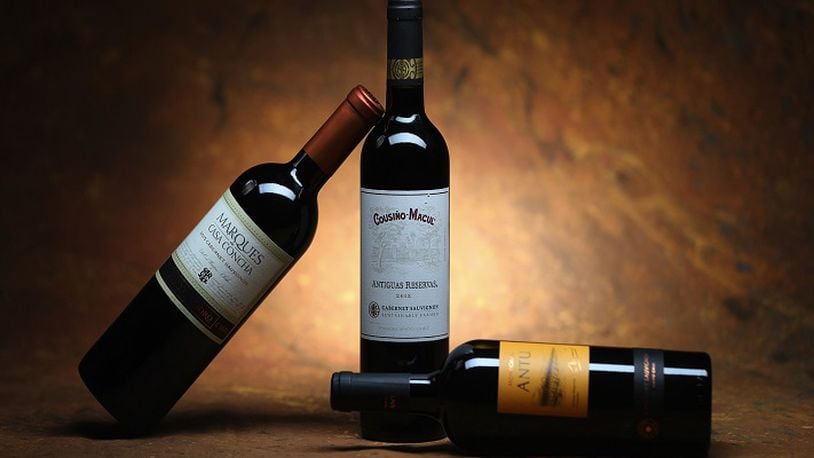Since those fledgling years in the ’80s and ’90s, Chile has become one of the world’s top wine-producing nations — recently ranked as high as fifth in world production — and cabernet sauvignon has played a big role in that development. While Chilean wine quality has improved since the early export days and prices have gone up, the general style of the country’s cabernet sauvignon remains fresh and supple. Generally you can expect juicy dark fruits, maybe a kiss of vanilla or chocolate, moderate tannins and an overall texture that leans toward the softer, silkier side. These are cabs that are easy and fun to drink, and thus easy to like. That is not to say that they are wimpy in any way. They are good partners for all of the usual cabernet sauvignon fare: grilled and roasted meats, stews, burgers and other hearty dishes.
Even if the wine is slightly more expensive at the entry level than it used to be, and significantly more expensive at the top level, the country’s cabernet sauvignon offerings are still worth seeking out and exploring. Most of it comes from the Maipo Valley, which is near the capital city of Santiago. The region is part of the appropriately named Central Valley, the would-be torso of the long and lean country that is wedged in between the Pacific Ocean to the west and the majestic Andes mountain range to the east. Most of Chile’s wine regions land between 32 and 38 degrees south, and the country spans little more than 200 miles at its widest point (compared with almost 2,700 miles north to south).
Outside interest in the Chilean wine industry — from technology and equipment to finance and expertise — has resulted in the regular production of high-end fine wine, and much of it relies on cabernet sauvignon. Those wines were not a part of this tasting (five of the nine wines listed below cost $20 or less, and the most expensive is $35) because, in fairness, those high-end wines occupy a category all their own. But interest in creating those wines at that level — interest from France, Spain and California — has surely helped improve cabernet sauvignon across the board in Chile, from the budget bottles to the top icon collectibles.
RECOMMENDED
Below are notes from a recent tasting of Chilean cabernet sauvignon. The bottles are listed in ascending order according to price. Except where otherwise noted, the wines are from the Maipo Valley.
2015 Vina Hacienda Araucano Reserva Cabernet Sauvignon. From the Colchagua Valley, this 100 percent varietal offered lip-smacking acidity plus bright red and blue fruits, herbs and green pepper that had a roasted, caramelized quality. $13
2013 Vina Cousino-Macul Antiguas Reservas Cabernet Sauvignon. Aged in French oak barrels for 12 months and an additional six months in the bottle, this wine offered cherry, earth, smoke, tea and spice. $16
2014 Vina Penalolen Cabernet Sauvignon. With bright notes of blackberry, cherry, cedar, vanilla, mocha and spice, this wine was luscious and decadent, with a long finish and 13.5 percent alcohol. $17
2014 Vina Santa Carolina Reserva de Familia Cabernet Sauvignon. Aged more than a year in oak barrels, this lively wine offered blackberry, cranberry, green pepper, cola, chocolate, vanilla and herbs. $20
2013 MontGras Antu Cabernet Sauvignon. Plum, smoke, raspberry, cola, spice, orange rind, cedar and bright acidity characterized this powerful wine, which clocks in at 14.5 percent alcohol. $20
2014 Lapostolle Cuvee Alexandre Cabernet Sauvignon. From old vines in the Colchagua Valley, this 90 percent cabernet sauvignon offered bright fresh fruit, including plum and blackberry, plus a hint of herbs and smoke. $24
2015 Vina Concha y Toro Marques de Casa Concha Cabernet Sauvignon. This wine had an abundance of plum, blackberry and cherry with supporting notes of green pepper, vanilla, cedar, smoke and spice. $25
2001 Aresti Family Collection Limited Edition 13 Years Aged Cabernet Sauvignon. A unique bottling, this soft and bright Curico Valley wine was full of black fruits, herbs, floral notes, vanilla and cola. $32
2013 Vina Valdivieso Caballo Loco Grand Cru Maipo. An 80/20 blend of cabernet sauvignon and cabernet franc, this rich, layered wine offered notes of dark fruits, cherry, pine, coffee, vanilla, black pepper and a lingering spicy finish. $35
About the Author
